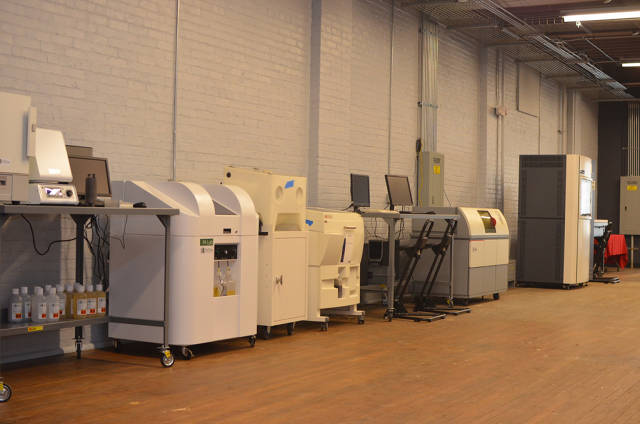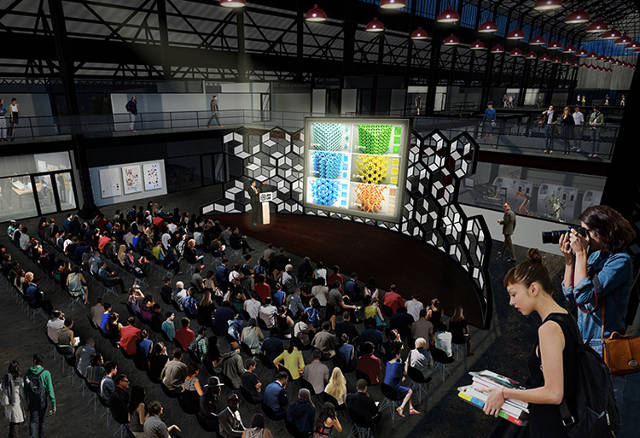America’s New Sustainable Manufacturing Hubs Will Breed Creativity And Jobs
WRITTEN BY: Sarah Krasley
Will this be how we revitalize the economy? Across the country, new multidisciplinary spaces for people to learn, experiment, and make are popping up, creating a new surge of jobs with them.
Obama’s State of the Union Address this year was a steady dopamine drip for me: “We have cleared away the rubble of crisis … making America a magnet for manufacturing … a once-shuttered warehouse is now a state-of-the art lab where new workers are mastering the 3-D printing that has the potential to revolutionize the way we make almost everything.” And be-still-my-heart: “we are finally poised to control our own energy future." He might have well described the Emerald City, as far as I was concerned.
I think it’s important to try and understand what exactly these “state-of-the art labs” or “manufacturing hubs” will be like and the direct role they play in employing more Americans while also making manufacturing processes smarter.

The aim of these hubs is to put smart, entrepreneurial people together with advanced manufacturing technology to come up with applications for that technology. Those applications will reduce waste in manufacturing processes, which will mean that U.S. manufacturers can charge less for their services. With new technology comes the need for newly skilled workers to wield it properly. So it’s a smart growth strategy: reduce the bottom line and increase profit; take profit and reinvest it in the company’s growth (i.e. adding employees).
It’s easy to imagine rows and rows of MakerBots humming away with workers waiting patiently for the parts and assemblies to come “hot off the press,” but the reality looksmore like this. Those are pictures from the pilot National Additive Manufacturing Innovation Institute in Youngstown, Ohio, that President Obama mentioned in his speech (Full disclosure: my employer, Autodesk, is involved in the pilot). As you can see, the machine tools are a mix of additive manufacturing technologies (like 3-D printing and laser sintering) and machine tools that you’d find in factories today that cut, stamp, and assemble parts together. The solutions coming out of the lab will probably be workflows comprised of elements from both.
We’ve looked at the theory and the technology pieces, but how will that induce growth? Another hub is a venture aptly named New Lab. The site, developed by New York-based real estate and design firm Macro Sea, is an 84,000-square-foot space in the Brooklyn Navy Yard. It is the consummate public-private partnership, backed by Speaker Christine Quinn, the NYC Council, the Empire State Development Corporation Regional Council, Mayor Bloomberg, and others.
It is slated to be kind of a non-denominational MIT Media Lab, where cross-pollination between green manufacturing startups, R&D teams, academia, designers, technologists, and digital fabricators will run rampant. There has been such great demand from groups wanting to get in that Macro Sea decided not to wait for the retrofit to be completed and has opened a beta space in an adjacent building where they are hosting tenants. The beta program will illuminate the best ways for New Lab to incubate these groups and give them excellent physical spaces in state-of-the-art co-working labs, war rooms, libraries, and fabrication shops.
It is slated to be kind of a non-denominational MIT Media Lab, where cross-pollination between green manufacturing startups, R&D teams, academia, designers, technologists, and digital fabricators will run rampant. There has been such great demand from groups wanting to get in that Macro Sea decided not to wait for the retrofit to be completed and has opened a beta space in an adjacent building where they are hosting tenants. The beta program will illuminate the best ways for New Lab to incubate these groups and give them excellent physical spaces in state-of-the-art co-working labs, war rooms, libraries, and fabrication shops.

The beta group contains some impressive members, including: Within Lab, DNI (Lowline Solar Collector), Hypersonic, and Terreform ONE, all of whom plan to join academic tenants like Columbia University Applied Building Sciences in the larger space when it opens. In this beta group alone there is a brain trust that can grow furniture, light underground areas, utilize technology to identify optimized forms for 3-D printing, and explore digitally fabricated spaces designed to morph over time.
The space will likely be one of the most prominent examples of resilient architecture in New York City. The cavernous space, once a repair shop for Navy ships, experienced flooding during Hurricane Sandy. Macro Sea, like most sane entities, expects megastorms to be a regular occurrence. They are tackling this strategically by bringing all electrical wires from above and installing a hoist that can be used to easily move equipment on the first floor to the second floor mezzanine at the next big hurricane warning. They’re also thinking about resiliency by creating slab flooring that can be wiped in the event of a surge.
The last important defining characteristic of these hubs is their ability to create jobs. How will they induce job creation? Alex Escamilla, senior project director at Macro Sea, explains: “We estimate 332 permanent jobs will come from New Lab on top of the 72 temporary construction jobs. The beauty of being in the Brooklyn Navy Yard is that, as these businesses grow, there is plenty of space for them to expand and hire more workers.”
While this may be a small number of jobs in the grand scheme of the overall jobs crisis, it’s an example of how innovation, creativity, and pursuing new areas of industry can be instrumental in the creation of not only jobs, but important advances in the application of technology. Hopefully we’ll start to see new labs crop up across the country and deliver the promise of Obama’s State of the Union.
The space will likely be one of the most prominent examples of resilient architecture in New York City. The cavernous space, once a repair shop for Navy ships, experienced flooding during Hurricane Sandy. Macro Sea, like most sane entities, expects megastorms to be a regular occurrence. They are tackling this strategically by bringing all electrical wires from above and installing a hoist that can be used to easily move equipment on the first floor to the second floor mezzanine at the next big hurricane warning. They’re also thinking about resiliency by creating slab flooring that can be wiped in the event of a surge.
The last important defining characteristic of these hubs is their ability to create jobs. How will they induce job creation? Alex Escamilla, senior project director at Macro Sea, explains: “We estimate 332 permanent jobs will come from New Lab on top of the 72 temporary construction jobs. The beauty of being in the Brooklyn Navy Yard is that, as these businesses grow, there is plenty of space for them to expand and hire more workers.”
While this may be a small number of jobs in the grand scheme of the overall jobs crisis, it’s an example of how innovation, creativity, and pursuing new areas of industry can be instrumental in the creation of not only jobs, but important advances in the application of technology. Hopefully we’ll start to see new labs crop up across the country and deliver the promise of Obama’s State of the Union.
No comments:
Post a Comment
Note: Only a member of this blog may post a comment.